I'm trying to add a satellite image on my map using OpenLayers 5.
The problem is that I'm not able to do this, because I've just found an option to add an image on the map passing the image extent (xmin, ymin, xmax, ymax) and not the bounding box. The image should fit inside the bounding box. For that reason, the image was distorted.
The image is in JPG file (attribute feature.properties.icon). Example: http://exampleserver.com/220/063/353LGN00/353LGN00_thumb_large.jpg
The result that I would like is something like this:
The result that I've got was that:
My code that adds this image on the map is the following:
import ImageLayer from 'ol/layer/Image'
import Static from 'ol/source/ImageStatic'
...
this.olmap = new Map({
target: 'map',
layers: [
baseLayerGroup, rasterLayerGroup, vectorLayer
],
view: new View({
projection: 'EPSG:4326',
center: [ -45.8392, -3.65286 ],
zoom: 8
})
})
...
this.rasterLayerGroup.getLayers().push(
new ImageLayer({
source: new Static({
url: feature.properties.icon,
projection: 'EPSG:4326',
imageExtent: [
feature.properties.bl_longitude, feature.properties.bl_latitude,
feature.properties.tr_longitude, feature.properties.tr_latitude
]
})
})
)
Would someone know how to pass the image bounding box instead of just the image extent?
Thank you in advance.
EDIT 1: Mike's solution
Through Mike's solution I was able to fix a bug that some images have (near to the equator line). For that reason, his answer solved my problem and it inserted the image in a better position that I was expecting in the moment that I created the question.
However, this solution worked to me with images near to the equator line. Images next to the poles stay distorted (Edit 2).
I send below a picture illustrating the final result:
EDIT 2: New problem?
I was testing some images and I have discovered a new bug. Now I have discovered that the image should fit inside the bounding box. If the image does not fit inside the bbox, it stays distorted, such as the print that I send below illustrating.
The image should fit inside the bbox like in the image below [PS 1]:
I believe that it can be a problem of reprojection, but I don't know, because both view projection and image projection is EPSG:4326.
I tried to follow the explanation about Raster Reprojection[1.] on Openlayers site, however I was not able to reproduce it, because, as I said, both projections (view and image) are the same (or they should be).
I send below the GeoJSON that contains the information related to the image above. The image can be found in "properties.icon" (http://www.dpi.inpe.br/newcatalog/tmp/MOD13Q1/2018/MOD13Q1.A2018017.h13v14.jpg). The bbox coordinates can be found in "geometry.coordinates" or in "properties.bl_latitude", "properties.bl_longitude", "properties.br_latitude" and so on. "bl" means "bottom left", "br" means "bottom right", "tl" means "top left" and "tr" means "top right". These coordinates inside "properties" are the same inside "geometry.coordinates".
{
"geometry": {
"coordinates": [
[
[
-77.7862,
-50
],
[
-100,
-60
],
[
-80,
-60
],
[
-62.229,
-50
],
[
-77.7862,
-50
]
]
],
"type": "Polygon"
},
"properties": {
"alternate": "http://www.dpi.inpe.br/opensearch/v2/granule.json?uid=MOD13Q1.A2018017.h13v14",
"auxpath": null,
"bitslips": null,
"bl_latitude": -60,
"bl_longitude": -100,
"br_latitude": -60,
"br_longitude": -80,
"centerlatitude": -55,
"centerlongitude": -80.0038,
"centertime": null,
"cloud": 0,
"cloudcovermethod": "M",
"dataset": "MOD13Q1",
"date": "2018-01-17T00:00:00",
"enclosure": [
{
"band": "evi",
"radiometric_processing": "SR",
"type": "MOSAIC",
"url": "http://www.dpi.inpe.br/newcatalog/tmp/MOD13Q1/2018/MOD13Q1.A2018017.h13v14.006.2018033223827.hdf"
},
{
"band": "ndvi",
"radiometric_processing": "SR",
"type": "MOSAIC",
"url": "http://www.dpi.inpe.br/newcatalog/tmp/MOD13Q1/2018/MOD13Q1.A2018017.h13v14.006.2018033223827.hdf"
},
...
],
"icon": "http://www.dpi.inpe.br/newcatalog/tmp/MOD13Q1/2018/MOD13Q1.A2018017.h13v14.jpg",
"id": "http://www.dpi.inpe.br/opensearch/v2/granule.json?uid=MOD13Q1.A2018017.h13v14",
"orbit": 0,
"path": 14,
"provider": "OP_CBERS1",
"row": 13,
"satellite": "T1",
"sensor": "MODIS",
"title": "MOD13Q1.A2018017.h13v14",
"tl_latitude": -50,
"tl_longitude": -77.7862,
"tr_latitude": -50,
"tr_longitude": -62.229,
"type": "IMAGES",
"updated": "2018-03-01T18:51:56",
"via": "http://www.dpi.inpe.br/opensearch/v2/metadata/MOD13Q1.A2018017.h13v14"
},
"type": "Feature"
}
Would someone have a new idea?
[PS 1]: The original code that does the image fits inside the bbox is a Leaflet code [2.] and I send it below:
var map = L.map('map').setView([-15.22, -53.23], 5)
...
var anchor = [
[feature.properties.tl_latitude, feature.properties.tl_longitude],
[feature.properties.tr_latitude, feature.properties.tr_longitude],
[feature.properties.br_latitude, feature.properties.br_longitude],
[feature.properties.bl_latitude, feature.properties.bl_longitude]
]
layer._quicklook = L.imageTransform(feature.properties.icon, anchor).addTo(map)
[1.] https://openlayers.org/en/latest/doc/tutorials/raster-reprojection.html




